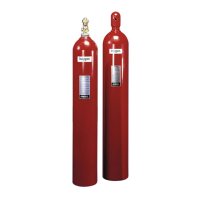SECTION IV
UL EX-4510 7-15-02 Page 4-2
REV. 1
Planning
INERGEN Supply Requirements:
•Will the cylinders be located in a dedicated space? If so,
record dimensions of that space.
• If the system is unbalanced, is the operating temperature
range within 60° to 80° F (15° to 27° C)?
• Determine if the floor will support the cylinders and brack-
eting. Assume 275 lbs/ft
2
for this requirement.
• Will the cylinder bracketing be secured to a wall? If so, is
the wall strong enough to support it and the cylinders?
• Will Uprights be required for the bracketing?
• Will Manifold Supports be required to support the mani-
fold?
• Will a reserve supply of agent be required? If so will it
need to be connected to the manifold?
• Will a discharge test be required?
Actuation and Alarm Requirements:
•Will the system be actuated automatically as well as man-
ually?
• What type of manual actuation (cable pull or pneumatic)
is required?
• Will multiple areas be protected by a single system? If so,
will the areas be protected separately or simultaneously?
• Identify the locations for all Manual Pull Stations.
• If automatic detection is a part of the system, provide ceil-
ing details.
• What types of alarm devices are required; audible and/or
visible?
• Where will the system actuation be annunciated?
• Does the hazard area require explosion-proof or weather-
proof wiring and devices?
• What devices need to be shut down or started up?
Identify the number of contacts required.
Piping and Wiring Information:
• Determine the cylinder location.
• Identify preferred supply piping routes.
• Indicate any obstructions to the piping or wiring runs.
• If the system includes Selector Valves, indicate their loca-
tion.
Ventilation and Leakage Concerns:
• Identify any unclosable openings regardless of their size.
• Advise the customer of the possible need to seal these
openings to prevent agent loss.
•Advise the customer of the possible need to provide pres-
sure venting during discharge.
• Determine the route venting will need to take to reach
outside atmosphere. Consult the INERGEN Pressure
Relief Venting Guide, Part No. 422793, for definition of
outside atmosphere.
• Will the venting route involve venting through other enclo-
sures or ducts? If so, provide details about the rooms or
duct routing information.
• If the venting will be through other enclosures, will they be
protected also? If so, will they be protected separately or
simultaneously?
• Will dampers be required for Inlet or Exhaust ducts? If so,
how will they be operated, electrically or pneumatically?

